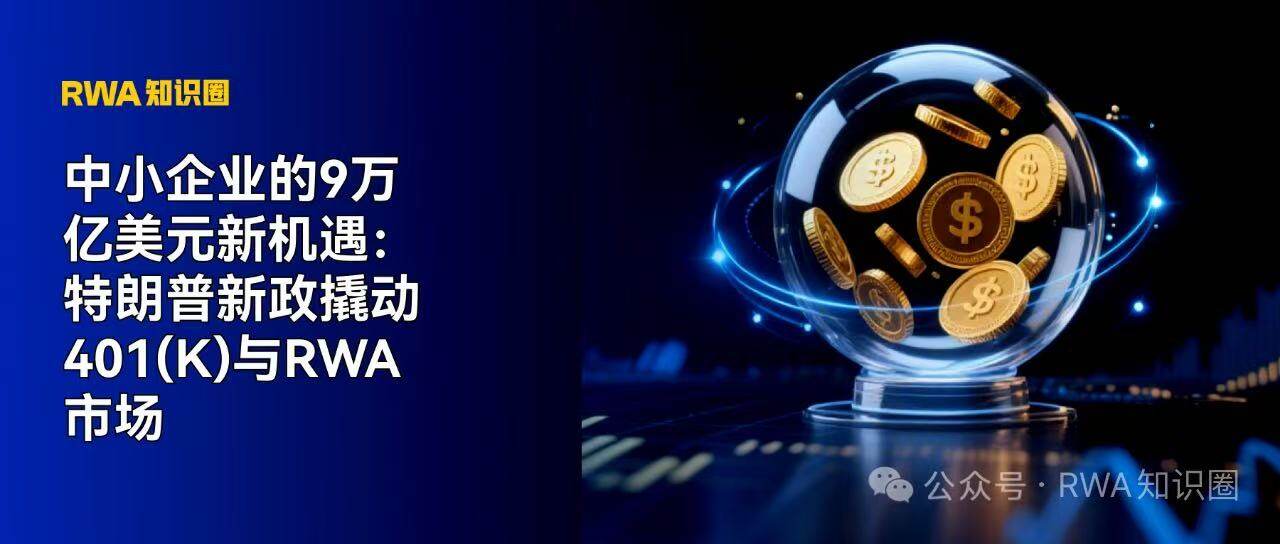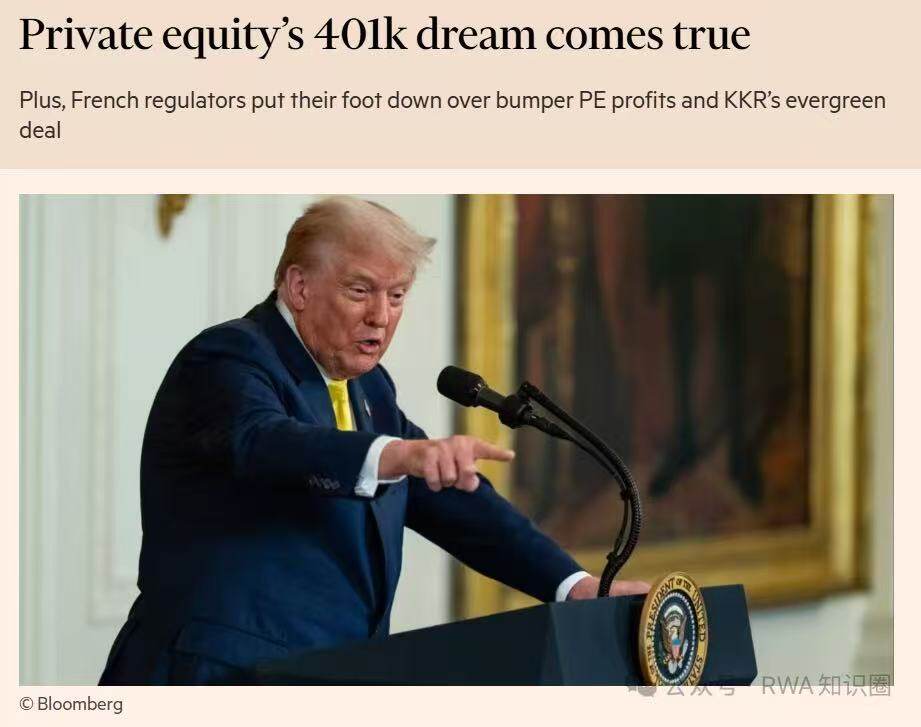
I. $9 Trillion Pension Policy Shakes the Market
On August 7, 2025, U.S. President Donald Trump signed an executive order allowing 401(k) pension accounts to invest in private equity, real estate, cryptocurrencies, and other alternative assets. The 401(k) is one of the most important retirement savings tools in the U.S., managing approximately $9 trillion in assets and covering the retirement funds of 90 million Americans. Market estimates suggest that if 401(k) plans allocate just 2% of their assets to the crypto market, it would mean an influx of about $170 billion in new funds.
This policy has given many RWA project teams hope, but the reality is that this funding will not be as evenly distributed as many imagine, especially for small and medium-sized enterprises, which may not have direct access to these new funds at all. The market opportunities that arise after the policy implementation require companies to leverage their capabilities and specialized services to truly seize them.

II. Development and Investment Logic of 401(k)
To gain the favor of 401(k) pension accounts for investment, one must first understand their development and operational logic. The 401(k) plan was established in 1978, initially aimed at tax-advantaged retirement savings, with investment targets limited to bonds and a small number of stocks. With the emergence of index funds and updates in market concepts, today, 401(k) accounts hold approximately 35% of their value in stocks, and the investment scope has gradually expanded to diversified assets.
401(k) is not an investment pool directly managed by the U.S. government; there is no mechanism for "government-set ratios and automatic fund inflows into certain projects." Investment rights are jointly led by individual participants and employers. Under this plan, pensions are not "freely distributed"; participants need to contribute funds annually for investment, and companies may provide matching subsidies. Therefore, investment decisions are made with great caution.
For small and medium-sized enterprises, it is nearly impossible to enter the 401(k) system solely by building their own public chain or randomly selecting a chain. Companies need to rely on professional RWA accelerators to select quality underlying assets, design reasonable economic models, connect with leading KOLs and media, and conduct precise promotions in line with market characteristics to attract investor attention.
III. Corporate Decision-Making: Fiduciary Duty and Investment Menu
In the 401(k) system, while individuals are responsible for investments, the available options are predetermined by employers in an investment menu. Employers have a fiduciary duty when designing the investment menu—guiding employees in their investments while avoiding excessive risks. When introducing alternative assets, they must fully consider:
- High fees
- Low liquidity
- Valuation difficulties
- Regulatory uncertainties
- Litigation risks
Historical experience shows that in the 19th century, courts deemed investing in common stocks as "imprudent behavior"; in the 1970s, when index funds were first introduced, many employers refused to offer them due to concerns about insufficient due diligence. Today, although the crypto industry has developed for over a decade, RWA, as a broader new concept, still requires time for Web 2 companies to accept. Initially, companies are more inclined to offer Bitcoin ETFs, Ethereum ETFs, and other products with institutional backing rather than directly including unverified RWA projects.
IV. Policy Space for Alternative Assets: Potential Pathways for RWA Entry
Having understood the investment logic of 401(k) and the fiduciary responsibilities of companies, we can further explore how RWA can enter the 401(k) investment menu. The executive order defines "alternative assets" to include:
- Private market investments (non-public equity or debt)
- Real estate and related debt instruments
- Infrastructure projects
- Commodities and long-term income strategies
If RWA products (such as real estate RWA, photovoltaic RWA, etc.) can be designed as actively managed funds or similar structures, they have the opportunity to be included in the corporate investment menu.
For small and medium-sized enterprises, the entry point lies in specialization and compliance:
- Leveraging RWA accelerators to connect with top public chains and exchanges
- Ensuring asset transparency and credibility through third-party authoritative audits
- Providing complete legal and operational documents to reduce investor concerns
Therefore, if small and medium-sized enterprises wish to enter the 401(k) investment menu, they must be well-prepared in project design, asset standardization, and compliance review.
V. Historical Experience and RWA Advantage Analysis
U.S. pension investment policies have evolved over the years, with asset allocation expanding from bonds to stocks, index funds, ETFs, and alternative assets. History shows that early investments in stocks were limited, prioritizing blue-chip stocks, while today, 35% of U.S. stock market value is held by pensions, proving that the market can gradually accept new asset classes.
Similarly, RWA, as an emerging asset type supported by underlying assets, will find it easier to gain recognition in the pension market with technological advancements, on-chain mapping, and improved auditing. In the next 180 days, agencies like the DOL and SEC will release detailed rules, with the policy officially implemented in 2026. Companies that lay the groundwork early will have an advantage in this massive market competition.
Additionally, RWA has the following advantages compared to traditional financial projects and pure cryptocurrencies:
- Asset transparency: RWA typically has physical assets as support, making asset conditions transparent and easy to audit.
- Stability: Compared to the high volatility of cryptocurrencies, underlying assets like real estate and photovoltaics offer relatively stable returns.
- Compliance: RWA products can be designed to meet traditional financial regulatory requirements, reducing compliance risks.
- Liquidity: Through tokenization, RWA can achieve asset digitization, enhancing liquidity.
These advantages make RWA an attractive option for institutional investors like pension funds.
VI. Key Strategies for Early Layout
If small and medium-sized enterprises wish to seize opportunities, they can consider the following strategies:
- Collaborate with professional RWA accelerators to improve project standardization and compliance levels
- Connect with top public chains and exchanges to ensure transaction and asset security
- Utilize authoritative third-party audits to increase investor confidence
- Develop clear marketing plans to ensure selection in the corporate investment menu
These strategies not only help companies enter the 401(k) menu but also establish long-term credibility among investors.
Trump's new policy opens a potential $9 trillion market for small and medium-sized enterprises, but entering it is not easy. Policy opportunities, professional compliance, and market promotion are all essential. Early layout and leveraging the resources of RWA accelerators will be key for companies to stand out in the upcoming pension investment wave.
免责声明:本文章仅代表作者个人观点,不代表本平台的立场和观点。本文章仅供信息分享,不构成对任何人的任何投资建议。用户与作者之间的任何争议,与本平台无关。如网页中刊载的文章或图片涉及侵权,请提供相关的权利证明和身份证明发送邮件到support@aicoin.com,本平台相关工作人员将会进行核查。



